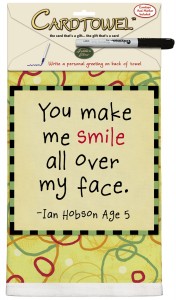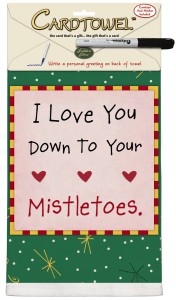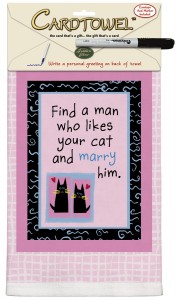Kate Harper is a well-known greeting card designer, with lots of experience and a wonderful blog for card entrepreneurs. She speaks about how her business developed and what she sees next for the industry.
AS: Kate, you made a major adjustment to your greeting card line when working with a helpful sales rep. What happened and what did you learn?
KH: I’ve been through several adjustments, but in the beginning one rep recommended I make my cards brighter colors and to think about what the message communicates when you look at the picture, even before you read the words. Reps also gave me feedback from the stores such as “people don’t get this joke” or “no one likes that card because it’s green” or “even though the sentiment is true, it’s depressing.”
AS: Could you talk a little about how transitioning from making your own handmade cards to licensing has changed your business and your life.
KH: It was a difficult decision to leave manufacturing because I had several people who depended on me for an income, but my business was growing to the point that I would have to relocate the studio and hire more staff and I really didn’t want to do that. For me, it was a lifestyle choice.
For fifteen years I ran a full time card publishing business, servicing thousands of stores and worked with over 100 sales reps. I felt lucky and blessed to be able to create designs and sell them and make a living from it, but I also found my life revolved more and more around packing and shipping cards, and very little to do with art.
Then I took a class with Cheryl Phelps on Art Licensing and my mouth fell open and it has been open ever since. I never realized art licensing even existed.
Life is completely different now, since I can do art full time and I have a lot more free time. I know some people say getting into art licensing is difficult, but I didn’t experience it that way. Perhaps because when I approach a company I bring a lot more to the table than just art skills. I bring 2,000 of my former accounts, sales statistics from my business and a background in the gift industry. I also understand what is involved in manufacturing a product, so it’s easy for me to put myself in the shoes of another company when they come up against challenges or misprint something. I try not to be too picky, because I know how incredibly difficult it is to match colors and make affordable products.
AS: Saleability is key to having a successful card line. What do you consider the most important factors in making a line saleable?
KH: The measuring stick I always use when evaluating my own cards is “Would I pull money out of my wallet right now and buy this card?” I also visualize a friend and imagine receiving or sending this card to her and asking myself: “How does this feel to send to her? Is it too weird? Is it condescending or unintentionally insulting?” Also, my silent motto to myself is “If you can make people laugh, you’ve already sold your product.”
I do abide with the greeting card standards that the image is the most important, because it causes the customer to pick up the card on the rack. Therefore you’ve got to have a strong image that evokes an emotional response.

AS: What do you see as the biggest challenge for greeting card entrepreneurs today?
KH: The card industry is suffering, no one can deny that. But I also have been working with companies who are redefining the meaning of what a greeting card is, such as Fiddler’s Elbow. I recently worked with them to develop a line of “Card Towels” – towels than can be sent as greeting cards.
I also am working with a second company on a similar concept (but different product) where the traditional me-to-you relationship is being adapted to a gift item in place of a greeting card. I see a strong future in the explosion of apps and ebooks and redefining what a greeting card is, in those contexts.
For example, on my own, I’ve been working on some concepts for Greeting Cards for the Kindle, I call “Kindle Cards.” My idea is to develop cards that can be sent to a friend’s Kindle, which is a completely different (and more positive) experience than receiving an e-card in an email. If you use a Kindle, you’ll understand why.
The good news, from my observation, is that the Handmade and alternative card business is doing OK and I’ve had a rep confirm this recently. I also have a friend whose $6.00 greeting cards keep selling out in a local store.
This year, when I went to the San Francisco Renegade Crafts Fair, people were standing in line to buy funky cards and gifts. This tells me that people still love to touch and send things. We just need to meet them in the places they want to be. That’s why I think trade shows should redefine what they are also.
A greeting card sales rep I know here locally whom I worked with for over a decade has a great idea for moving gift shows into a new generation, which is to change them to a format like the Renegade fair.
If you allow designers in at more affordable prices, in a funkier, unsterile modern setting, you are going to attract more interesting vendors, products, younger buyers and more buyers overall. Also, if you have this type of show in a variety of metro areas, they can start to reflect individual design styles from different parts of the country.






Great interview! Thanks for sharing this. I totally agree that there is a place for “social expression” whatever form it may take. And that we need to re-think the trade show experience for exhibitors and buyers alike.
Interesting and informative interview. I think it would be wonderful it the trade show experience would be re-done. Thanks for sharing!
This is a very inspiring article filled with solid information and exciting ideas.
Love the concept of creating alternative greetings for customers.
Thanks – Kate is one of the best people I know for great insight into the greeting card industry
Great article I found this on LinkedIn with one of my groups. Always looking to grow from the knowledge of others who have been in the business for years.
Thank you
Hello. I have been working on a line of gifts and greeting cards for about a year now that I would like to license. I don’t know what to do so I am trying to research as much as possible. I don’t have the means to create the products that I come up with and have been using the printable card making kits from WalMart to make my cards. Can you give me some direction? I would appreciate any tidbit. Thank you.
Brandy
Hi Kate
Thanks for the great article. I have been selling fine art photography greeting cards for about 5 years now and
found your information on the greeting card industry very helpful. I have a long ways to go but now with
the info you have shared I feel I can have more success. Timothy